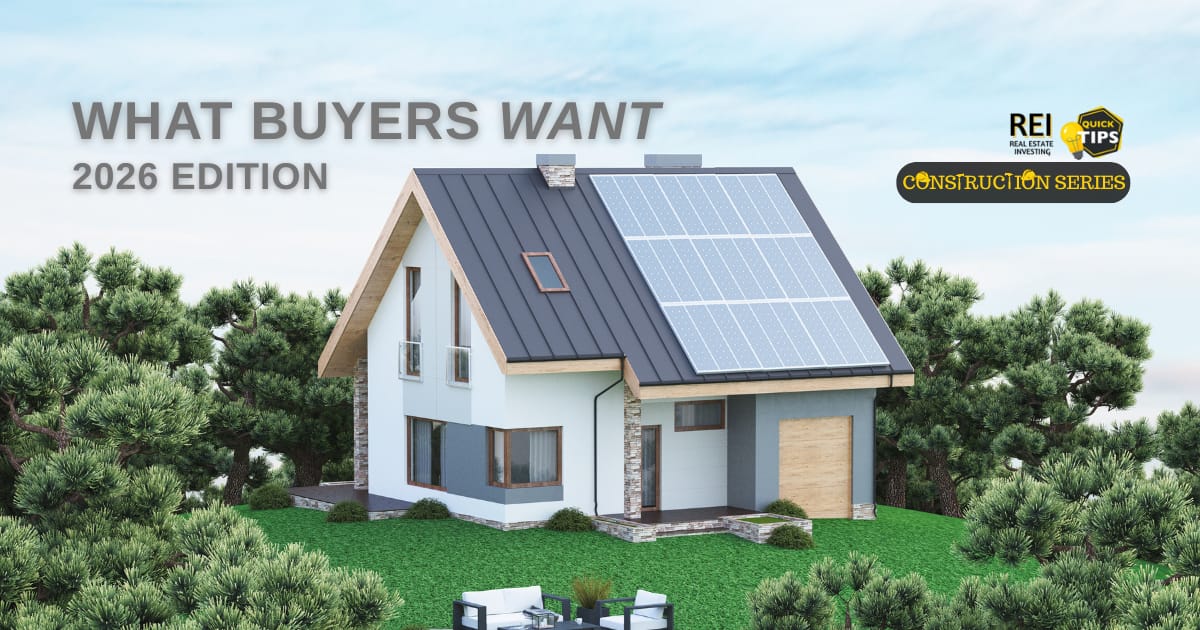- Real Estate Investing Quick Tips
- Posts
- What Buyers Want
What Buyers Want
2026 Edition
More than $10k in debt? We can help.
Debt happens. Getting out starts here.
Millions of Americans are tackling debt right now.
Whether it’s credit cards, loans, or medical bills, the right plan can help you take control again. Money.com's team researched trusted debt relief programs that actually work.
Answer a few quick questions to find your best path forward and see how much you could save. answer a few short questions, and get your free rate today.
What Buyers Want in 2026

The housing market of 2026 is shaped by one overarching reality: buyers are more intentional than ever. Uncertainty with interest rates, inflation in construction costs, and an aging housing stock have made people think harder about where their money goes. With the help of AI, first time buyers are more informed than ever. For agents, investors, and builders, this means one thing — design and function must align with what buyers really value.
Across the country, several themes are emerging in buyer behavior. These aren’t just passing trends — they reflect deeper shifts in how people live, work, and think about homeownership.
Energy Efficiency and Sustainability
Energy costs aren’t coming down, and buyers know it. Homes with solar panels, EV charging stations, energy-efficient windows, and modern insulation are commanding premium prices. Even small upgrades — like LED lighting, smart thermostats, and tankless water heaters — make a measurable difference in perceived value.
Buyers want lower utility bills and homes that feel “future-proof.” Investors should think of these upgrades as not just environmental, but financial — they translate directly to resale appeal and appraisal strength.
Investor takeaway: Focus on cost-effective improvements that lower monthly expenses. A $2,000 solar-ready setup can add far more than that in perceived value.
Health and Wellness Spaces
Homebuyers are now prioritizing spaces that promote health, calm, and recovery from daily stress. Wellness rooms, home gyms, spa-inspired bathrooms, saunas, and outdoor relaxation areas are becoming common wish-list items.
Think of this as the “retreat effect.” After several years of global uncertainty, buyers want their homes to be restorative. That could mean better natural light, low-VOC materials, and even spaces designed for yoga, stretching, or quiet reading.
Investor takeaway: You don’t need to build a luxury spa. Even small touches like a rainfall shower, light wood finishes, and greenery can create the wellness vibe buyers crave.
Flexible and Multi-Purpose Spaces
The open floor plan isn’t dead, but it’s evolving. Buyers now want adaptable spaces that balance openness with privacy. Home offices that double as guest rooms, window-seat nooks, and convertible bonus spaces are key.
Remote and hybrid work aren’t going away, and families are rethinking space usage. Flexibility is now a selling feature.
Investor takeaway: When renovating, think in terms of zones rather than rooms. Create defined areas that serve multiple functions. A small wall with built-ins can turn a large, undefined area into a marketable “multi-purpose room.”
Resilience and Disaster-Readiness
With insurance rates rising and natural disasters in the news, buyers are paying closer attention to how well a property can handle the unexpected. Elevated foundations, hurricane-rated windows, fire-resistant landscaping, and backup generators are no longer luxury options — they’re peace-of-mind features.
This is especially important in states like Florida, Texas, and California, where weather and fire risks influence both pricing and insurability.
Investor takeaway: If you’re building or remodeling, highlight durability. Marketing phrases like “storm-ready” or “fire-resistant exterior” resonate with 2026 buyers.
Craftsmanship and Character
The era of cookie-cutter “builder grade” finishes is fading. Buyers want homes that feel unique — even in new construction. Reclaimed materials, bold paint choices, custom woodwork, and color-drenched interiors are trending.
A little craftsmanship goes a long way. One feature wall with real wood paneling or a distinctive color palette can elevate an entire property.
Investor takeaway: Quality beats quantity. Choose one or two standout design elements that express care and individuality. It’s better to be remembered for great detail than for a collection of forgettable upgrades.
Outdoor Living and Entertaining
Outdoor spaces are now viewed as extensions of indoor living. Patios, covered seating areas, outdoor kitchens, and fire pits continue to rank high among buyer priorities.
The new buzzword is “indoor-outdoor flow.” Large glass doors, shade structures, and durable flooring that transitions seamlessly from kitchen to patio make a strong visual impact in listings and showings.
Investor takeaway: Even if you can’t build a full outdoor kitchen, create an inviting outdoor zone. Add lighting, simple pavers, or a small pergola — buyers will see lifestyle potential.
The Investor’s Edge in 2026
Successful investors recognize patterns before they peak. The trends above aren’t fads — they’re signals. Buyers are moving toward homes that are energy-smart, wellness-oriented, adaptable, resilient, distinctive, and connected to nature.
You don’t have to implement all six. Start with two or three that make sense for your price point and market. Whether you’re flipping, building new, or renovating a rental, the message is the same:
Design for the life people want, not just the house they need.
That’s how you’ll attract modern buyers — and build profits that last.


